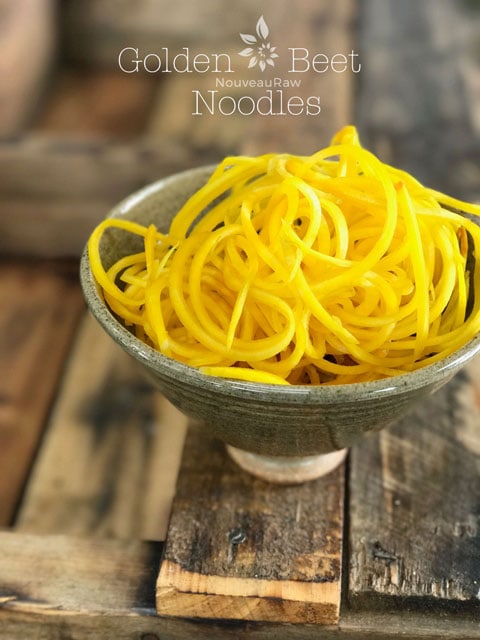Golden Beet Noodles

 Add to favorites
Add to favorites

~ raw, vegan, gluten-free ~
Beetroots come in a wide range of colors and sizes, such as red, white, golden/yellow, and even striped. Each color provides a slightly different flavor and levels of sweetness. Golden beets are slightly sweeter than their red counterparts.
Golden or yellow beets are heart-healthy, excellent kidney and body cleansers, high in powerful antioxidants, lowers blood pressure, lowers cholesterol, treats anemia and fatigue, and more.
Word of Caution
If you are predisposed to forming kidney stones, you could avoid beets. Kidney stones are caused by a buildup of insoluble calcium and create a painful mass in the kidneys. Beetroot is rich in oxalate, which can create calcium oxalate stones. (1)
Ever head of Beeturia?
Beeturia is the passing of red or pink urine after eating beetroots or foods colored with beetroot extract or beetroot pigments. The color is caused by the excretion of betalain (betacyanin) pigments such as betanin. (1) I have experienced this in the past, I just never knew there was an official name for it. Now I do. :)
How to Select a Beet
Selecting a beet has nothing to do with rhythm. Haha, Get it… beet (beat as in drum). Oy-vey, smacks forehead. Nothing worse than getting home with a bad selection of produce. First off, choose beets that are rich in color and feel heavy for their size. They should be firm to the touch and have a bright green top that is still attached.
Beets grow in various sizes, I have found that it is best to stay close to baseball size and under to ensure the freshest flavor and the most nutrients. Though I know we gravitate to LARGE produce, bigger is NOT always better.
Cleaning & Storing Beets
It is best to wash beets right before consumption to slow down deterioration. Gently scrubbed them under running water to remove any grit or dirt. I prefer to peel the skins, but if roasting them, I will leave them on. It’s a matter of preference.
To store them, cut off the green stems first thing. They will suck up moisture and nutrients. After separating the root and greens, store them in separate bags in the crisper. If kept in a cool compartment, beets will keep for a few weeks.
Ingredients:
Preparation:
- Be sure to pick the freshest, in season, beetroot that you can find. This will ensure that you get the best tasting noodles possible.
- Look for firm roots. If the flesh is mushy, it won’t work on the spiralizer.
- With a potato peeler, remove the skin and then cut a flat top and bottom.
- Place the unit on the countertop and press down on the spiralizer to engage the suction cups and secure.
- Insert the blade cartridge you’d like to use, make sure that it clicks into place.
- Place the center of the root onto the cylinder part of the blade and press the teeth of the handle into the other side of it.
- Take hold of the handle on the bottom (the horizontal one) with one hand and then spin the handle with the teeth to spiralize. Press down with steady forward pressure, using the handle that you’re gripping, for best results.
- Before dressing up the noodles, take scissors when you’re done spiralizing and cut the noodles into manageable sized pieces. Just grab a bunch of noodles and roughly snip. Or enjoy that never-ending noodle!
- You can make noodles in advance, they should keep for 5-7 days in the fridge, without sauce.
To clean the spiralizer:
- Purchase an inexpensive handled brush for cleaning the blade parts and hard to reach parts on the unit. This will save your fingers and prevent nicks from happening on the blades, keeping them nice and sharp.
- Be sure to quickly rinse the unit after creating noodles. The juices from certain root veggies can stain the unit.
- Dry the blades well before putting them away.
Different Types of Spiralizers
GEFU Spiralfix Spiral Slicer
- Can be used in the left or right hand.
- 4 different widths of cut for creative recipes: Spiral cut across the entire width of the material, 3 mm, 6 mm, or 12 mm wide adjustable via adjusting wheel
- Folding lid for easy filling
- Detachable non-slip holding container for safe standing
- Material: stainless steel, ABS plastic, SAN
- Splash-guard lid with drive unit detachable for easy cleaning. Dishwasher-safe
Spiralizer 7-Blade Vegetable Slicer
- This slicer comes with 7 different blades which give you 7 completely different textures and shapes.
- Comes with 420 high carbon cutlery grade stainless steel blades and stronger making it possible to Spiralize harder root vegetables like sweet potatoes and turnips that previously broke Spiralizer handles
Potato Peeler
- Wash and peel the outer skin off of the veggie.
- Hold the veggie at one end and in a long stroke motion, run the peeler from top to bottom.
- Rotate the veggie in a circular motion and continue peeling until you reach the seeded core (if there is one). Stop once you reach this. Don’t throw it away, use it in a smoothie or salad.
© AmieSue.com
Tags: Alkaline, Dairy Free, Gluten Free, No Dehydration Required, Nut Free, Refined Sugar Free, Vegan



 Add to favorites
Add to favorites